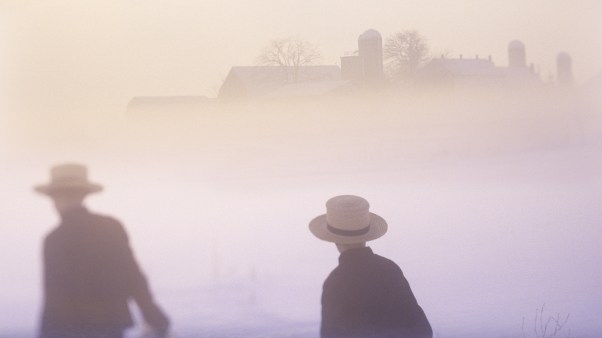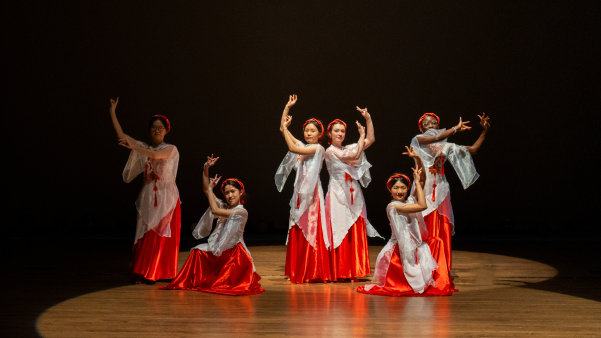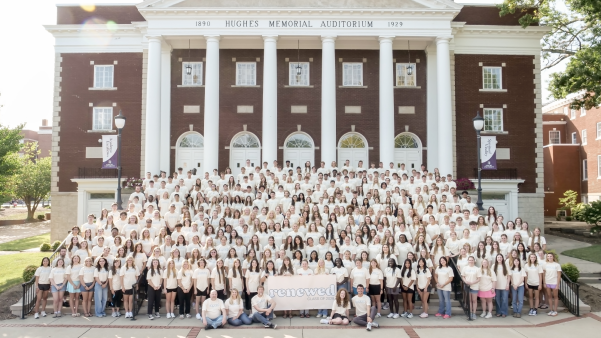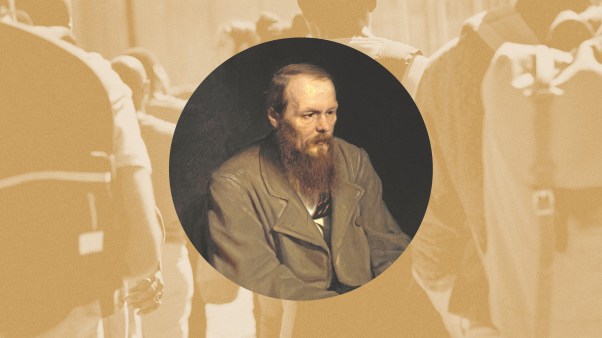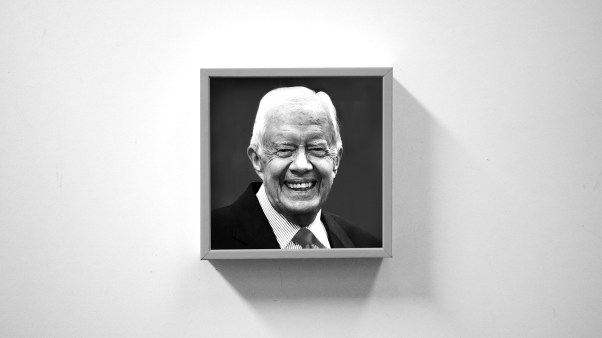Incredulity. Laughter. Even dismay. That's how my friends responded when I told them that my daughter and I were going to the National Museum of Funeral History for my birthday. I realized the choice might not be everyone's cup of tea, but why, I wondered, weren't more people intrigued or at least interested in the one event in which we will each be the main attraction? Many people these days arrange for their final appearance ahead of time. So wouldn't they have at least a mild curiosity about how it all works?
Apparently not. My daughter and I were the only two customers that morning at the repository of funeral history, a flat buff building on the north side of Houston. It must be one of the least visited of the city's many museums. This despite the fact that the Trip Advisor website listed it as number ten among Houston's 90 great sites to visit. Hundreds, even thousands of people visit the city's justly famous Museum of Science and Natural History each day, so why wouldn't the ethnography of death interest them as well?
All cultures have had some kind of ritual for disposing of dead bodies. Archaeologists have dug up evidence that Neanderthals placed flowers in the graves of their dead. Egyptians, at least the rich and powerful ones, created large graves for themselves and their prized possessions, which sometimes included living wives and servants. The nomadic biblical patriarchs were buried in special locations that could be visited by their descendants. For example, Jacob's body was embalmed in Egypt and carried by Joseph back to the family burial plot near Mamre, where Abraham and Sarah had earlier been interred.
But not all cultures committed their loved ones to the grave. Exposing bodies to the elements and carrion-scavenging birds has been practiced in varying cultures in different parts of the globe. In North America, plains Indians built scaffolds or placed bodies in trees for birds to pick the flesh from their bones. Fearing the demon that took possession of the body after death, Zoroastrians in Iran, Afghanistan, and India built squat "towers of silence" for their dead. The remains were considered dangerously polluted. When Islamic Iran made such practices illegal and mandated burial, its Zoroastrian citizens lined graves with stones and then poured in concrete to prevent contact of the polluted body with the earth.
Until lately, funerals have almost always been religious in nature. Some sort of clergy—priest, shaman, chaplain, or pastor—has presided. Now, however, funerals have become almost as do-it-yourself as weddings. And preparation of the body, which used to be a family or community duty, is now a thriving business, buttressed by legislation, lobbyists, and licensing.
To provide the industry with future leaders, the Museum of Funeral History shares the building with the Commonwealth Institute of Funeral Service. It offers an online Associate Degree of Applied Science that takes only twelve months to complete if one has already passed the four required general education courses: biology, English, psychology, and college algebra.
Probably the funereal practice that strikes westerners as strangest, if not most appalling, is "sky burial." It has been practiced for centuries by Tibetan Tantric Buddhists. After the soul has departed, the body is considered just another carcass. It is taken to a mountaintop, hacked to pieces, sometimes by a priest, and eaten by vultures. In fact, the Tibetan word for this kind of funeral means "giving alms to the birds." Afterward, the bones are pounded to powder and mixed with barley flour, tea, and yak butter, presumably to make the bone powder more palatable to the birds.
The fear of pollution or "uncleanness" by touching a dead body, along with prescriptions for purification, pervades a number of cultures, including the biblical Israelites. The Levitical laws forbade even touching the carcasses of certain animals. Mosaic law provided the rituals of purification and set a limit to the unclean time-out—seven days. On the third day the ancient undertaker had to be sprinkled with a solution of water and the ashes of a red heifer before rejoining the community.
Some cultures, however, expend a good deal of care for the dead, embalming being the most obvious example. Why such a deep cultural divide over bodily disposal? How is it that some commemorate their dead by erecting various kinds of monuments in land set aside and sanctified for burial, while others discard corpses so insouciantly?
My daughter and I bought our $10 tickets in the gift shop stocked with mementoes ranging from t-shirts printed with the museum's motto ("Any day above ground is a good day") to Dracula-blood candy. I went for the go-cup sporting the slogan "In Dog Years I'm Dead."
We found the museum displays well lit, spaciously arranged, and obviously well-funded. Being a National Museum, the displays focus mostly on American funeral customs. In this country's early history, we followed the Western European custom of burial. Family members washed and prepared the body for burial, built the coffin, dug the grave, and, aided by a clergyman if one was available, committed the body to the earth. With the growth of more prosperous towns and cities, the distance to cemeteries was sometimes considerable, and horse-drawn hearses, of which the museum holds a number of examples, carried the casketed body. Some coffins were plain, others more ornate, In the colder climes where the ground froze hard, the body might be laid out in a "cooling room" till the spring thaw made grave-digging easier. In any case, corpses were not usually disemboweled or otherwise physically invaded during the antebellum period in America. Even in death, bodies maintained something of their integrity and sanctity.
This was true of slave burial as well. Suzanne Smith, in her book To Serve the Living: Funeral Directors and the African American Way of Death, discusses how slaves buried their dead after dark in "hush harbors," a practice brought from West Africa. When such funerals drew large crowds, of mourners, however, they were quelled, perceived by whites as occasions for plotting slave revolts.
As early as the late 18th century, black urban freedmen formed benevolent societies often modeled on the Masons, Knights of Pythias, and various immigrant associations. They provided a safety net to care for their sick, widows, and orphans, as well as insuring burials. This suited the white communities who preferred not to have people of color buried in their own churchyards.
But the Civil War brought changes to burial practices that eventually encompassed all of American society. In This Republic of Suffering: Death and the American Civil War, Drew Gilpin Faust reports how embalming became widespread when tens of thousands of dead soldiers littered battlefields, too many for the survivors to bury. Family members came with hopes of finding the remains of beloved sons and husbands only to discover them rotting in the fields.
Fortuitously, Dr. Thomas Holmes, a New York surgeon who had been experimenting with chemicals substitutes for the arsenic and mercury used to preserve cadavers for medical students, came up with a safer fluid to inject into the arteries of corpses to preserve them. He had found his niche—battlefield embalming. Thus preserved, bodies could be shipped home via train for their loved ones to bury. Holmes followed Northern armies from battle to battle, advertising his services. His flyers targeted "prudential soldiers" who were urged to purchase prepaid embalming insurance.
By the end of the war, embalming had become so accepted that Abraham Lincoln's body was thus preserved for its cross-country journey from Washington to Illinois, though according to local reports, it arrived somewhat the worse for wear. The funeral museum is faithful to this historical report. Its effigy of Lincoln in his black, cloth-covered coffin, decorated only by the intricate brass bosses lining the upper edge, shows him to be gray and shrunken.
The museum displays a replica of Holmes' battlefield embalming tent as well as a 19th-century coffin workshop. Next to these displays is a 1920s embalming room, complete with a newfangled electrical pump for injecting the liquid preservative into the arteries.
Though embalming substantially increased the cost of a funeral, it grew in popularity among all levels of society, both black and white. With this additional service, funerals thus became increasingly commercialized and quasi-medicalized. Trade organizations, citing health concerns, lobbied state governments to pass laws requiring embalming for any corpse not buried within 48 hours.
The 1960s desegregation laws did not change people's preference for funeral establishments. Both churches and funeral homes retained their black and white divisions. Ironically, however, as Smith points out, this kind of self-segregation, even to the grave, gave black funeral directors a secure market that their white counterparts were not eager to take over. In addition, the growing expense of funerals meant a rise in economic and social status for the occupation, which became known first as undertaker, then mortician, and finally funeral director. In black communities these men were often at the top of their communities' income scale, especially as African Americans continued to prefer burial over the cheaper option of cremation. From that position of security, funeral directors emerged in many places as leaders among their people.
Today, the increasingly popular option of cremation is slowly taking hold in black communities as well as white. It is easy enough to see why we are abandoning burial. Cremation costs approximately a quarter of the outlay for a burial. Also, survivors get to do what they like with the "cremains." A friend of mine bought a handmade honey pot (a la Winnie the Pooh) for her husband's ashes. She intends for her own to be added to the same pot upon her death. Another friend had her father's ashes deposited in the columbarium along the back wall of our church. Her husband's were scattered at sea in the Caribbean
Some people stick with burial as a way to assert their individuality. The museum is proud of its collection of "fantasy coffins" carved in Ghana to represent the life of the deceased—for example a canoe for a fisherman, or a chicken for a nurturing tribal mother. Westerners have discovered this service and have ordered coffins carved as a Mercedes Benz and a KLM airliner.
I buried both my parents ten years ago. In the town's swank new funeral home, their bodies, laid out in satinlined coffins and pumped full of formaldehyde, looked not at all "natural," even if those who came to the "viewing" assured me they did. My father was shrunken in the Air Force uniform he hadn't worn in thirty years. My mother, gaunt from decades of Parkinson's, looked severe in a swept-back hairdo she had never worn in life. But I was following the directions of their prepaid funeral plans.
My family's earlier generations had been laid out in the town's old funeral parlor, hemmed in now by fast food restaurants and a dry cleaners. The new, upscale mortuary was more elegant than any home either I or my parents had inhabited in life. Marble floors, enormous bouquets on mahogany etageres, reception rooms furnished with gold-framed mirrors the size of my front porch, and chairs and loveseats vaguely reminiscent of Louis XIV. In the ladies' restroom, the basins held little river rocks to deflect the noise of a running tap that might intrude on the mourner's meditative mood.
In the funeral museum, the early American funeral furniture I saw would have been more in keeping with my parents' lives. But the plain wood coffins on display there, often made at home, were not an available choice at the state-of-the-art mortuary. And while I might long for the romantic vision of a country churchyard, the reality is that there are not enough burial plots left to hold all the suburbanites, much less the residents of high-rise buildings. Thus, most of us will be incinerated.
As I wandered among the museum displays, questions about our culture's funeral practices niggled at me. How do we decide on our bodily disposal? My parents' generation still flinched at the thought of cremation, partly because of family tradition and partly because of vague theological reluctance, a fiery end being associated with hell.
Cultures seem to divide along the lines of earth burial and cremation. Some, such as Muslims, have firm strictures against cremation, others, like Hindus, against burial. The Christian tradition is more ambivalent. Up through the Middle Ages, cremation was disallowed as it was considered a rebuff to the doctrine of the resurrection of the body. Nevertheless, the sheer quantity of battle dead and plague victims sometimes necessitated burning. The Enlightenment brought a broader acceptance of cremation, and in the 19th century the first crematoria were built in England, Germany, and the United States.
Protestant denominations, by and large, had no official position on the manner of bodily disposal, although they generally held that God's creative ability would not be limited by resurrecting bodies from ashes any more than from dust if, indeed, he needs either one to work with.
In 1963, Pope Paul VI lifted the Roman Catholic ban on cremation, though the body itself had to be present for any funeral mass, and subsequent burial of the ashes is mandated. The Eastern Orthodox churches, however, have never sanctioned the practice of cremation.
I was relieved my parents had made their own burial plans, even if their choices weren't mine. My first choice would be a plains Indian scaffold from which I would offer up my own "alms to the birds," specifically the buzzards that do a good job of cleaning up our Texas roadways. But, alas, that is not an option legally open to me.
Like most people, I don't enjoy visualizing the actual process of what comes after the funeral—my body, despite embalming, jellifying within a few weeks, then leaking away the liquids to leave a dried corpse turning to dust. The picture of my body sliding into a retort heated to a thousand degrees, the fluids vaporizing and floating eventually into the atmosphere, leaving behind a mere four pounds of ash and bone fragments, sounds somehow cleaner. The refiner's fire. But burning also has several associations, visual and historical, that aren't too palatable either.
The Museum of Funeral History obviously favors burial. Otherwise, what would be the point of displaying all those hearses, from the horsedrawn model to the Cadillac that transported Grace Kelly's body? Ashes have no need of hearses. They can be mailed to the survivor in a cardboard or plastic box. In The Undertaking: Life Studies from the Dismal Trade, Thomas Lynch favors burial as the more respectful and efficacious ritual for those who mourn.
With burial, the survivors at the graveside probably feel more involved in the death ritual. But my parents took the last two spots in our family cemetery plot, and I've visited it only once in the decade since their deaths. Even then I didn't feel as if I were visiting them, only their shared brass memorial headstone. By now, their bodies are simply dust and bones. I didn't even feel they were there when their bodies were wheeled out on gurneys.
And what of the resurrection of the body? Will their dust or ashes be swept up and reconstituted like instant tea or coffee? Who knows? Speculation seems silly.
Though I haven't left any instructions for my funeral yet, other than some hymns I want, I suspect that I will be cremated and my ashes either placed in the columbarium or buried under our biggest oak tree with our cats and dog, to be raised at last—however God pleases to remake me—incorruptible.
Virginia Stem Owens is the author of Caring for Mother: A Daughter's Long Goodbye (Westminster John Knox Press).
Copyright © 2014 by the author or Christianity Today/Books & Culture magazine. Click here for reprint information on Books & Culture.




